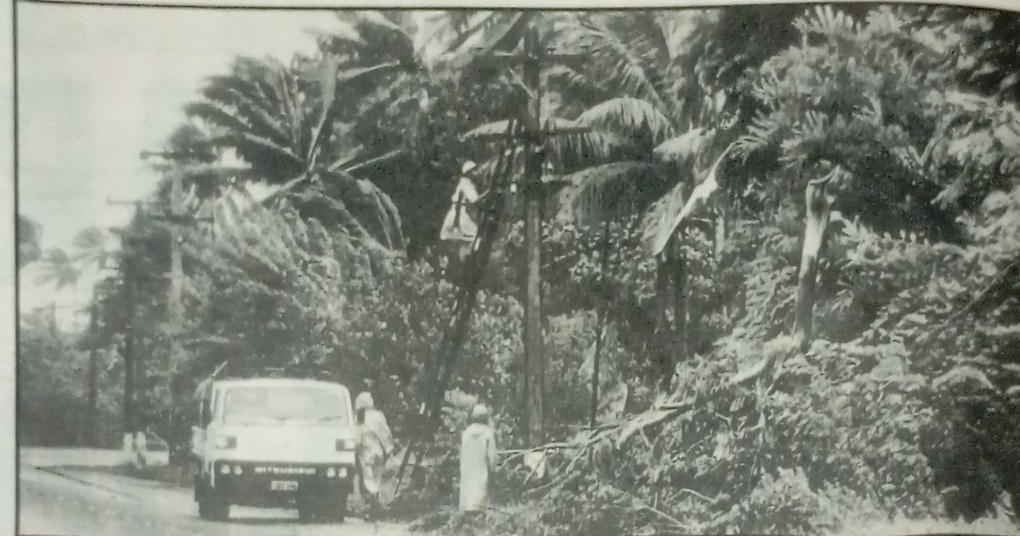In the vast expanse of the world’s oceans, a hidden threat silently proliferates, imperiling maritime industries and ecosystems, right here in Fiji. Biofouling, which according to panel discussions held at the Suva Yacht Club organised by Maritime Safety Authority of Fiji (MSAF) is the accumulation of marine organisms on submerged surfaces, presents a formidable challenge with far-reaching implications for global and regional trade, environmental conservation, and human health. As the prevalence of biofouling continues to rise in the Pacific, especially here in Fiji, understanding its impact and implementing effective mitigation measures have become imperative.
The nature of biofouling
According to MSAF legal officer Miriama Latianara, biofouling occurs when marine organisms, ranging from microscopic algae to barnacles and mollusks, attach themselves to submerged surfaces such as ship hulls, offshore structures, and underwater equipment. Over time, these organisms form complex biofilms, compromising the efficiency and functionality of maritime assets. “The cluster or colony of microorganisms that builds up on vessels depends on whether they have been sitting for an extended period of time, and this will determine what is being transported from one place to another,” Ms Latianara said “The niche areas on vessels that aquatic organisms can latch onto, such as hulls, anchors, anchor wells and sea chests, mostly places where the vessel is under water.” “But it’s no just vessels, any structures that are in direct contact with water,” she says “we have our platoons, our boats and stuff like that can also have invasive species latch on to.”
Impacts of biofouling
Among the panellists that addressed the topic of biofouling was Mr Isoa Korovulavula Acting Director, Institute of Applied Science, University of the South Pacific (USP). He spoke on the implications of biofouling on the environment, economy and social lives of people. “People have been trying to define what Blue economy is, but, we often overlook that Blue economy is very relevant to what we are discussing (biofouling),” says Mr Korovulavula “For us here in the Pacific, we heavily rely on marine resources, and should this issue persist, in time our marine resources will begin to deplete.”
Disruption of ecological balance
Mr Korovulavula said that at its core, biofouling disrupted the delicate balance of marine ecosystems by altering habitat structures and species interactions. “The accumulation of fouling organisms on natural substrates such as rocks, corals, and seabeds can smother and suffocate native flora and fauna, leading to habitat degradation and loss of biodiversity,” he said. “This disturbance is made worse by invasive species that are carried through biofouling, which outcompetes our very own Fijian, native species for resources and has a domino effect on the environment.”
Spread of invasive species
“One of the most pressing environmental implications of biofouling is the spread of invasive species to new habitats.” Mr Korovulavula said. Hitchhiking on ships and maritime structures, fouling organisms can be inadvertently transported across oceans, colonising and proliferating in previously unaffected areas. Once established, invasive species can wreak havoc on native ecosystems, outcompeting indigenous species, altering food webs, and destabilising ecological processes.
Impact on commercial fisheries
“When we talk about the impacts of biofouling, we are looking at a wider picture, we need to connect the dots,” he said. “Yes, environment is severely impacted but that means the economy and our lives are also impacted.” Mr Korovulavula said, “The environmental consequences of biofouling extend beyond ecological disruption to impact commercial fisheries and aquaculture operations.”
“Fouling organisms can clog fishing gear, impede vessel propulsion, and damage aquaculture infrastructure, resulting in economic losses and operational challenges for the fishing industry.
“The spread of invasive species from biofouling poses a direct threat to fish stocks and shellfish populations, worsening the pressures on already vulnerable marine resources,” he stated.
Societal impact
“During COVID-19 when shops were closed, my office is right next to the sea, so I would see people going to fish for food,” Dr Korovulavula said “so imagine, if these invasive species start to diminish our resources through competing with our native species for resources.” He mentioned that because these invasive species are alien to Fiji and other Pacific Islands, we don’t have the natural defence systems, like predators, to reduce the invasive population. In Fiji, where traditional fishing practices and subsistence lifestyles are deeply intertwined with the marine environment, the impact of biofouling can be particularly devastating. These invasive organisms can colonise coral reefs, mangroves, and other critical marine habitats, outcompeting native species and degrading ecosystem health. And that ultimately impacts the coastal communities and communities that are highly dependent on marine resources.
Human health concerns
Something that wasn’t addressed by the panellists, which I believe also poses a significant threat, is that biofouling also raises concerns for human health, particularly in aquaculture and recreational water activities. The presence of fouling organisms on submerged infrastructure increases the risk of exposure to infectious diseases, toxins, and allergens, posing potential health hazards for workers and recreational users alike.
Secondary cause
The major cause of biofouling is the natural process of marine organisms colonising submerged surfaces such as vessels, platoons and boats. But, the second major causality that’s was brought to light by Dr Korovulavula was pollution, specifically, plastic pollution. Plastics and other forms of pollution that float in the ocean can serve as vectors for the transport of invasive species, posing significant ecological and economic risks to marine ecosystems worldwide. As these pollutants drift with ocean currents, they can inadvertently carry fouling organisms from one location to another, facilitating their dispersal and colonisation of new habitats. “Plastics will be able to hold and carry these invasive species from place to place,” Mr Korovulavula said. “So pollution is not only disrupting ecosystems but also bringing in invasive species to occupy these ecosystems.” Mr Korovulavula promoted a deeper dive into the interconnection of pollution and biofouling. And according to a study done by European Maritime Safety Agency (EMSA) pollution can contribute to biofouling, particularly through the introduction of nutrients and organic matter into aquatic environments. So the study showed that excessive nutrient inputs from sources such as agricultural runoff, sewage discharge, and industrial activities can fuel the growth of fouling organisms by promoting algal blooms and bacterial growth. These organisms, according to the study, then settle on submerged surfaces, forming biofilms and providing a substrate for the attachment of larger fouling organisms such as barnacles, mussels, and algae. Pollutants such as heavy metals, pesticides, and hydrocarbons can accumulate on underwater structures and hulls, creating toxic environments that deter fouling organisms or disrupt their growth and development. While this may initially seem beneficial in preventing biofouling, it can also have negative consequences for marine ecosystems by impairing the health of native species, altering community dynamics, and compromising ecosystem functions.
Mitigation strategies — policy reform
“Addressing the threat of biofouling requires a multi-faceted approach encompassing prevention, monitoring, and control measures,” says Ms Latianara. “One important tool in the management of biofouling is antifouling coating, which is made to prevent marine organisms from adhering.” According to Ms Latianara, currently, Fiji lacks specific laws and regulations addressing biofouling, leaving a regulatory gap that poses risks to marine ecosystems and maritime industries. “The Government must give top priority to developing and putting into place comprehensive biofouling management measures because of the growing risk of invasive species introduction through biofouling.” The importance of implementing a biofouling policy in Fiji cannot be overstated. As a nation heavily reliant on marine resources for food security, livelihoods, and tourism revenue, Fiji stands to suffer profound ecological and economic consequences if left unaddressed. By implementing a biofouling policy, Fiji can proactively address the risks posed by biofouling and mitigate its adverse impacts on marine ecosystems and coastal communities. By enacting legislation that mandates biosecurity protocols for ships entering Fijian waters, such as hull cleaning and ballast water treatment requirements, the Government can help mitigate the spread of invasive species and protect the health and integrity of marine ecosystems.
The role of NGOs and statutory bodies
Also among the panellists were Mavis Joseph-Logavatu, IMO technical cooperation officer for the Pacific Community (SPC). She touched on how non-governmental organisations (NGOs) and statutory bodies play a vital role in curbing biofouling and its associated environmental impacts. “A unique and key factor that contributes to the IMOs mission, is the inclusion of industrial bodies and NGOs,” she said “This inclusion ensures that regulations and guiding materials are conducted in consultations with industry and environmental NGOs so that their expertise can be leveraged.”
These organisations often collaborate with governments, industry stakeholders, and local communities to implement biofouling management strategies and raise awareness about its ecological consequences. The collaboration between NGOs and statutory bodies is essential for developing comprehensive biofouling management strategies that balance environmental protection, economic sustainability, and regulatory compliance. Ms Logavatu elluded that by working together, these organisations can effectively curb the spread of invasive species, protect marine ecosystems, and promote the sustainable use of our oceans for future generations.
Gender equality for innovation
In the traditionally male-dominated maritime industry, fostering inclusivity of women is not only a matter of equity but also a catalyst for innovation and progress, especially against the fight with Invasive species. “By embracing diversity and empowering women to participate fully in maritime activities, the industry stands to benefit from a wealth of untapped talent, perspectives, and ideas that can drive innovation, enhance efficiency, and promote sustainable development,” says Rifat Tanjila the Gender Advisor for Women in Maritime of the Pacific Community (SPC). “The inclusion of women in maritime for innovation begins with creating a supportive and inclusive work environment that values diversity and provides equal opportunities for all.” The inclusion of women in the maritime industry can play a significant role in the development of technology for biofouling management and prevention. Women bring diverse perspectives, skills, and expertise to the table, which are essential for driving innovation and finding creative solutions to complex challenges such as biofouling. Women’s participation in STEM (science, technology, engineering, and mathematics) fields is crucial for advancing research and development efforts aimed at understanding biofouling dynamics and identifying effective mitigation strategies. By encouraging and supporting women in STEM education and careers, the maritime industry can tap into a larger talent pool and benefit from a broader range of ideas and approaches to addressing biofouling issues. Biofouling represents a significant environmental and economic challenge for maritime industries and coastal communities worldwide. The accumulation of marine organisms on submerged surfaces not only degrades infrastructure and increases operational costs but also poses risks to marine ecosystems, biodiversity, and human health. Addressing the complex issue of biofouling requires a multifaceted approach that encompasses research, regulation, innovation, and collaboration across sectors and stakeholders. By implementing effective biofouling management strategies, such as hull cleaning, ballast water treatment, and biosecurity protocols, the maritime industry can mitigate the spread of invasive species, protect marine habitats, and ensure the sustainability of ocean resources. Moreover, promoting inclusivity, diversity, and women’s participation in the maritime sector is essential for driving innovation, advancing technology development, and fostering a culture of sustainability and resilience in the face of biofouling challenges. “If we don’t call for action now and if we continue to overlook this issue, in the coming years, Fiji will have a big problem,” says Dr Korovulavula.
Ultimately, by working together and embracing innovative solutions, we can overcome the threat of biofouling and safeguard the health and integrity of our oceans for generations to come.





